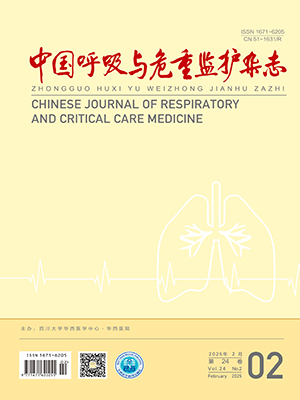| 1. |
Timsit JF,Zahar JR,Chevret S. Attributable mortality of ventilator-associated pneumonia. Curr Opin Crit Care,2011,17:464-471.
|
| 2. |
Melsen WG,Rovers MM,Groenwold RH,et al. Attributable mortality of ventilator-associated pneumonia:a meta-analysis of individual patient data from randomised prevention studies. Lancet Infect Dis,2013,13:665-671.
|
| 3. |
Kollef MH,Hamilton CW,Ernst FR. Economic impact of ventilator-associated pneumonia in a large matched cohort. Infect Control Hosp Epidemiol,2012,33:250-256.
|
| 4. |
Sandiumenge A,Rello J. Ventilator-associated pneumonia caused by ESKAPE organisms:cause,clinical features,and management. Curr Opin Pulm Med,2012,18:187-193.
|
| 5. |
Montgomery AB,Vallance S,Abuan T,et al. A randomized double-blind placebo-controlled dose-escalation phase 1 study of aerosolized amikacin and fosfomycin delivered via the PARI investigational eFlow® inline nebulizer system in mechanically ventilated patients. J Aerosol Med Pulm Drug Deliv,2014,27:441-448.
|
| 6. |
Ryan G,Singh M,Dwan K. Inhaled antibiotics for long-term therapy in cystic fibrosis. Cochrane Database Syst Rev,2011:CD001021.
|
| 7. |
Tumbarello M,De Pascale G,Trecarichi EM,et al. Effect of aerosolized colistin as adjunctive treatment on the outcomes of microbiologically documented ventilator-associated pneumonia caused by colistin-only susceptible Gram-negative bacteria. Chest,2013,29:1768-1775.
|
| 8. |
Kofteridis DP,Alexopoulou C,Valachis A,et al. Aerosolized plus intravenous colistin versus intravenous colistin alone for the treatment of ventilator-associated pneumonia:a matched case-control study. Clin Infect Dis,2010,51:1238-1244.
|
| 9. |
Rattanaumpawan P,Lorsutthitham J,Ungprasert P,et al. Randomized controlled trial of nebulized colistimethate sodium as adjunctive therapy of ventilator-associated pneumonia caused by Gram-negative bacteria. J Antimicrob Chemother,2010,65:2645-2649.
|
| 10. |
中华医学会重症医学分会.呼吸机相关性肺炎诊断、预防和治疗指南(2013).中华内科杂志,2013,52:524-543.
|
| 11. |
ATS. Guidelines for the management of adults with hospital-acquired,ventilator-associated,and healthcare-associated pneumonia. Am J Respir Crit Care Med,2005,171:388-416.
|
| 12. |
孟凡亮,刘枫.雾化吸入抗生素治疗呼吸机相关性肺炎的现状.中国呼吸与危重监护杂志,2013,12:636-639.
|
| 13. |
刘朝晖,陈劲龙,谢长江,等.广州地区呼吸机相关性肺炎临床流行病学和病原学分析.中国呼吸与危重监护杂志,2007,6:93-96.
|
| 14. |
杨春辉,李虎,薛杨勇,等.雾化吸入阿米卡星气道分泌物及血药动力学特点.内科急危重症杂志,2013,19:165-167.
|
| 15. |
Lu Q,Yang J,Liu Z,et al. Nebulized ceftazidime and amikacin in ventilator-associated pneumonia caused by Pseudomonas aeruginosa. Am J Respir Crit Care Med,2011,184:106-115.
|
| 16. |
汪复,朱德妹,胡付品,等.2012年中国CHINET细菌耐药性监测.中国感染与化疗杂志,2013,13:321-330.
|




